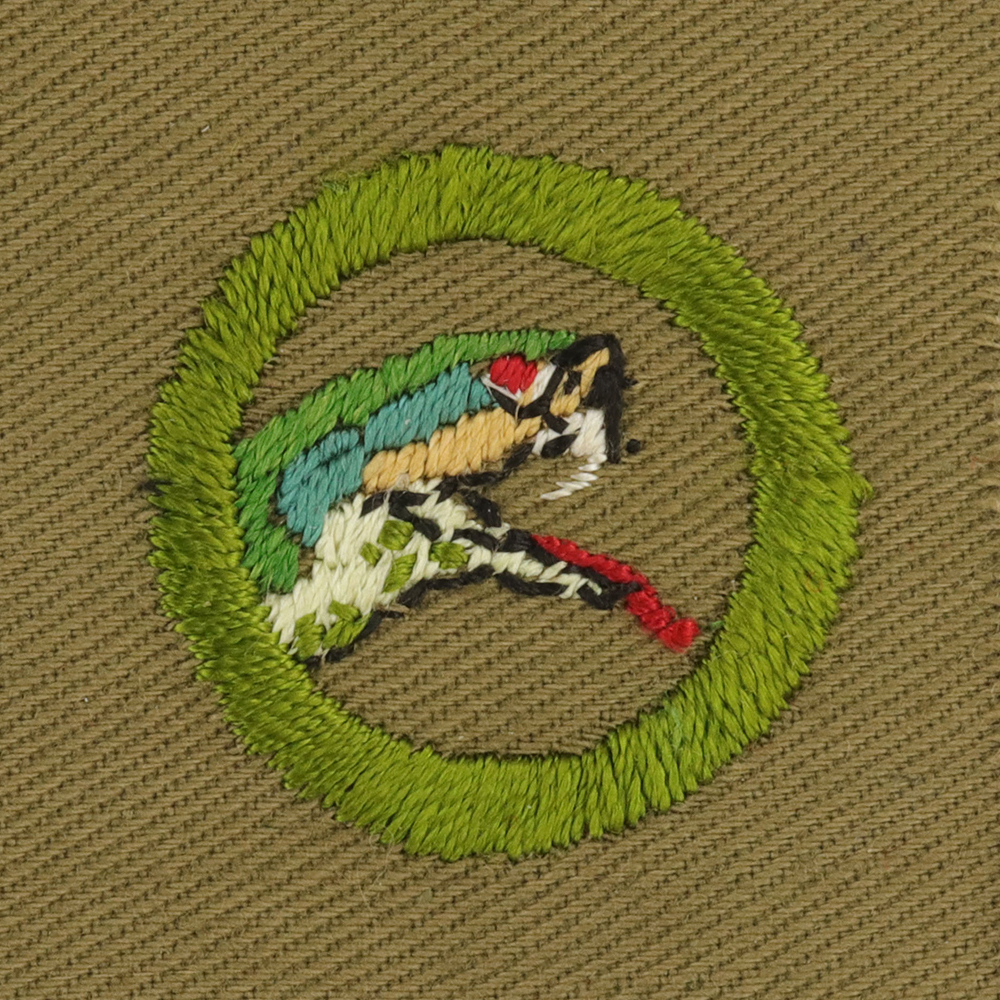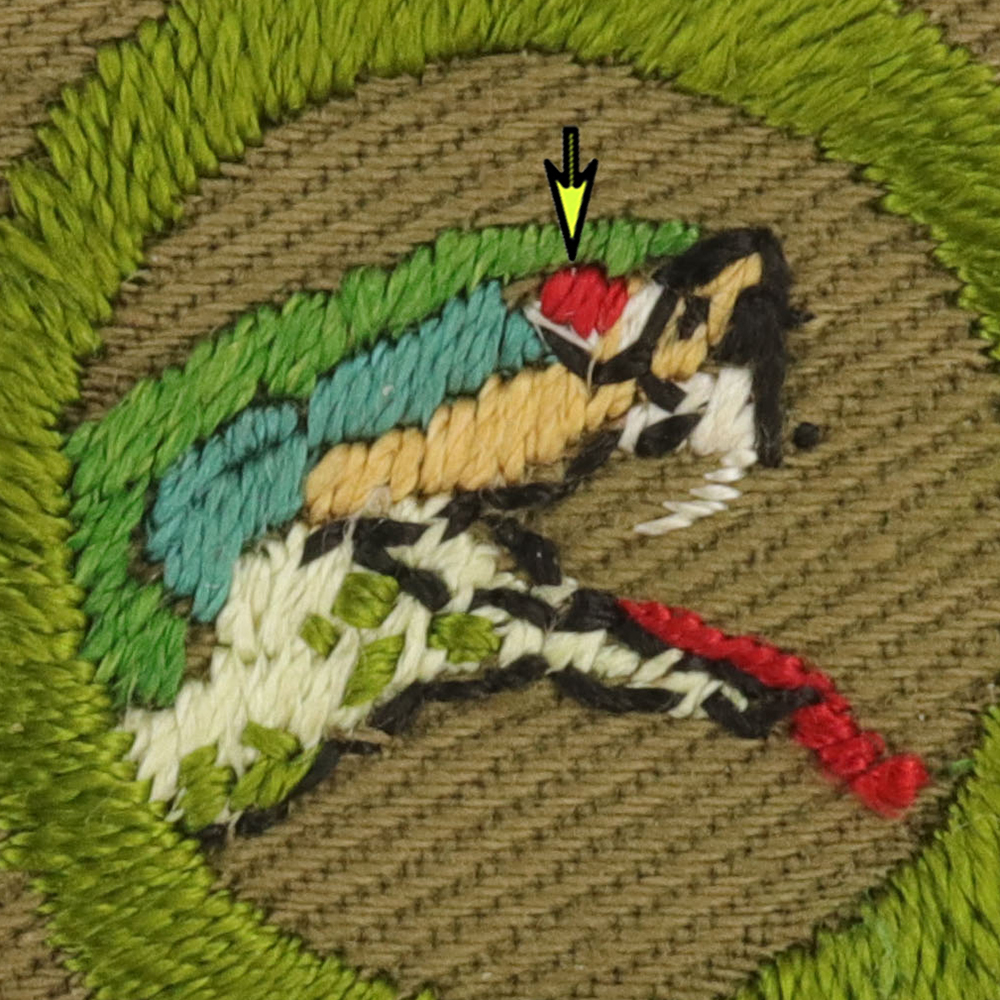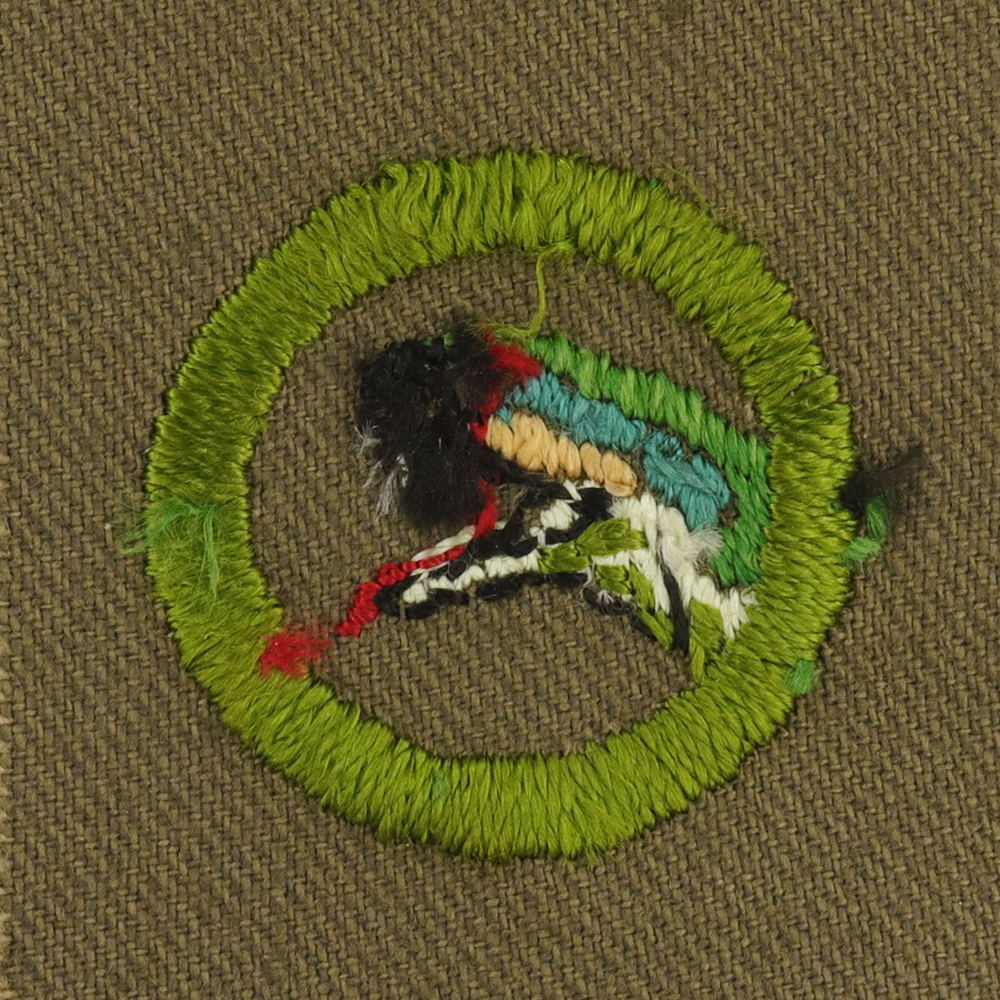
Fig. 1: RepStu-AT2-Front
- Cloth: Heavyweight tan right twill
- Embroidery: Silk continuous

Fig. 2: RepStu-AT2-Magnified
- Design: Thick snake head, red eye

Fig. 3: RepStu-AT2-Reverse
- Back: Black imprint
Item Name: Reptile Study 1927 - 1933
Item ID: RepStu-AT2
Collector Rating: 1
Pamphlets Used to Earn this Badge
Requirements March 1927 until April 1930
To obtain a merit badge for Reptile Study, a scout must, through observation, reading, or other means of information:
1. Know what representative species of reptiles are found in his own state or locality, snakes, lizards, turtles, crocodiles.
2. Know distribution and typical life history of the crocodilians inhabiting the United States.
3. Be able to distinguish by their shape, size, markings, heads, tails and fangs or teeth, and describe the four types of poisonous snakes. What characteristic is common to three of them? What poisonous snake is known by its vivid coloration? Know whether these snakes are aggressive or whether they bite only in self-defense. Know the location and use of the poisonous fangs. Know, in a general way, the distribution of poisonous snakes of the United States.
Know how far a snake can strike.
4. Know eight harmless snakes, four of which feed on destructive rodents. Know how snakes capture and eat their food. Know why all snakes are sometimes blind. Know how the young are produced--from eggs or born alive. Know something concerning the usefulness of snakes to man. Know why and how a snake sheds its skin, the function of the tongue, and the difference between snakes and lizards as to eyes and ears.
5. Be able to recognize and describe five kinds of turtles, one of which shall be edible. Describe the typical life history of the turtle; where the eggs are laid, when laid, usual number, color, shape and covering. Tell how the eggs are incubated and the approximate length of the incubation period.
6. Know the position of the reptiles in the animal kingdom.
Explain why, where and when reptiles hibernate, and duration of the hibernation period.
7. Know what first aid treatment should be given in case of poison snake bite, and the reason for same.
Requirements March 1931 until July 1933
1. Know what representative species of reptile (snakes, lizards, turtles, crocodiles) are found in his own state or locality. Be able to identify all these species.
2. Know distribution and typical life history of the crocodile inhabiting the United States.
3. Be able to distinguish the poisonous reptiles of the United States.
(a) The one kind of poisonous lizard.
(b) Four kinds of poisonous snake, by shape, size, markings, heads, tails or by teeth (fangs).
(c) The location and operation of the fangs of the four kinds of snake.
(d) General distribution of the poisonous forms.
(e) Whether these poisonous snakes are aggressive or defensive, and how far they can strike.
4. Know eight harmless snakes, four of which feed on destructive rodents, and know the food of each. Know how they capture and eat their food. Know something of the usefulness of the snake to man. Know how young snakes are produced--from eggs or living young; how and why a snake sheds its skin; why snakes are partly blind prior to shedding; the function of the snake tongue.
5. Know some of the important differences between the group (snakes, lizards, turtles, crocodiles) as to (a) eyes, (b) ears, (c) teeth, (d) heart, (e) lungs, (f) limbs, (g) tails, (h) scales (shell).
6. (a) Know the typical life history of lizards, how young are produced--from eggs or living young. Recognize and describe five kinds of turtle, one of which shall be edible; Or--
(b) Know the typical life history of lizards; how young are produced--from eggs or living young. Recognize and describe five kinds, preferably common to his own region. Know the common food of lizards and their usefulness to man in thus controlling pests. Know how and why a lizard will drop its tail and how it regrows.
7. Know the relative position of reptiles in the animal kingdom. Explain why, where and when reptiles hibernate, and the duration of the hibernation period.
8. (a) Know what first aid treatment should be given in case of poison snake bite and the reasons for the same.
(b) Know the use of anti-venin serum.
Requirements July 1933 until December 1943
1. Know what representative species of reptile (snakes, lizards, turtles, crocodiles) are found in his own state or locality. Be able to identify all these species.
2. Know distribution and typical life history of the crocodilians inhabiting the United States.
3. Be able to distinguish the poisonous reptiles of the United States.
(a) The one kind of poisonous lizard.
(b) Four kinds of poisonous snake, by shape, size, markings, heads, tails or by teeth (fangs).
(c) The location and operation of the fangs of the four kinds of snake.
(d) General distribution of the poisonous forms.
(e) Whether these poisonous snakes are aggressive or defensive, and how far they can strike.
4. Know eight harmless snakes, four of which feed on destructive rodents, and know the food of each. Know how they capture and eat their food, know something of the usefulness of the snake to man. Know how young snakes are produced--from eggs or living young; how and why a snake sheds its skin; why snakes are partly blind prior to shedding; the function of the snake tongue.
5. Know some of the important differences between the groups (snakes, lizards, turtles, crocodiles) as to (a) eyes, (b) ears, (c) teeth, (d) heart, (e) lungs, (f) limbs, (g) tails, (h) scales (shell).
6. (a) Know the typical life history of lizards; how young are produced--from eggs or living young. Recognize and describe five kinds, preferably common to his own region. Know the common food of lizard and their usefulness to man in thus controlling pests. Know how and why a lizard will drop its tail and how it regrows.
7. Know the relative position of reptiles in the animal kingdom. Explain why, where and when reptiles hibernate, and the duration of the hibernation period.
8. Know what first aid treatment should be given in case of poison snake bite and the reasons for the same.



